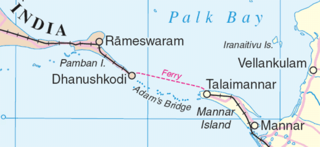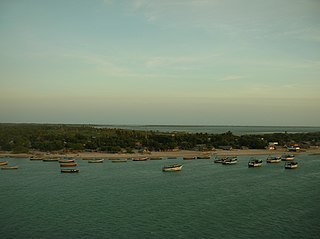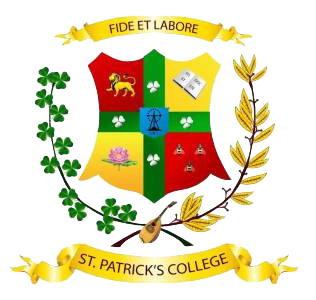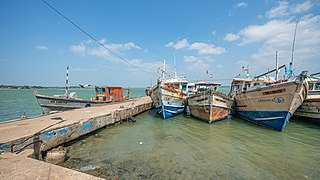
The Palk Strait is a strait between the Tamil Nadu state of India and the Jaffna District of the Northern Province of the island nation of Sri Lanka. It connects the Bay of Bengal in the northeast with Palk Bay in the southwest. It is 40 to 85 miles wide and 85 miles long. Several rivers flow into it, including the Vaigai River of Tamil Nadu. The strait is named after Robert Palk, who was a governor of Madras (1755–1763) during the Company Raj period.

Rameswaram is a municipality in the Ramanathapuram district of the Indian state of Tamil Nadu. It is on Pamban Island separated from mainland India by the Pamban channel and is about 40 kilometres (25 mi) from Mannar Island, Sri Lanka. It is in the Gulf of Mannar, at the tip of the Indian peninsula. Pamban Island, also known as Rameswaram Island, is connected to mainland India by the Pamban Bridge. Rameswaram is the terminus of the railway line from Chennai and Madurai. Together with Varanasi, it is considered to be one of the holiest places in India to Hindus and is part of the Char Dham pilgrimage.

Point Pedro, also known as Paruthithurai is a town, located in Jaffna District, Sri Lanka, at the northernmost point of the island.

The Sea Tigers was the naval wing of the Liberation Tigers of Tamil Eelam during the Sri Lankan Civil War. It was founded in 1984. The Sea Tigers had a number of small but effective suicide bomber vessels. During its existence it had gained a reputation as a capable adversary for the Sri Lankan Navy. During the civil war, the Sea Tigers had sunk at least 29 Sri Lankan small inshore patrol boats, 20 Dvora-class fast patrol boats, 3 gunboats, 2 Large surveillance command ships, and one freighter.

Koneswaram Temple of Trincomalee or Thirukonamalai Konesar Temple – The Temple of the Thousand Pillars and Dakshina-Then Kailasam is a classical-medieval Hindu temple complex in Trincomalee, a Hindu religious pilgrimage centre in Eastern Province, Sri Lanka. The most sacred of the Pancha Ishwarams of Sri Lanka, it was built significantly during the ancient period on top of Konesar Malai, a promontory overlooking Trincomalee District, Gokarna bay and the Indian Ocean. The monument contains its main shrine to Shiva in the form Kona-Ishvara, shortened to Konesar.

Negombo is a major city in Sri Lanka, situated on the west coast and at the mouth of the Negombo Lagoon, in the Western Province, 38 km (24 mi) from Colombo via the Colombo–Katunayake Expressway and the nearest major city from the Bandaranaike International Airport.
Chunnakam is a town, located 9.7 km (6.0 mi) north of Jaffna. It is one of the important commercial centres in Jaffna. The original name of the town was Mayilani. In northern Sri Lanka, Chunnakam is only second to Jaffna in terms of population density and commercial activities in and around its neighbourhoods.

The Shrine of Our Lady of Madhu is a Roman Catholic Marian shrine in Mannar district of Sri Lanka. With a history of more than 400 years, the shrine acts as a center of pilgrimage and worship for Sri Lankan Catholics. The site is considered as the holiest Catholic shrine in the island and is a well known place of devotion for both Tamil and Sinhalese Catholics. The church has been a symbol of unity not just between Tamils and Sinhalese but also between people of different religions, including Buddhists, Hindus and Protestants.

Pungudutivu or Pungai Idu Tivu is a small island composed of number villages that is just west of the Jaffna Peninsula in Sri Lankan Tamil dominated Northern Province. It is divided into 12 wards internally, each corresponding a major settlement.

Katchatheevu is an uninhabited island in Sri Lanka. The island was governed by British Ceylon from 1921. Though the Indian government never controlled it, the island remained disputed until 1974 between India and Sri Lanka when India recognised Sri Lanka's sovereignty over the island.

Pamban Island, also known as Rameswaram Island, is an island located between peninsular India and Sri Lanka, on the Adam's Bridge archipelago. The second largest island in the latter, Pamban Island belongs to India and forms the Rameswaram taluk of the Ramanathapuram district of the state of Tamil Nadu. It is the largest island in Tamil Nadu by area. The principal town in the island is the pilgrimage centre of Rameswaram.

India–Sri Lanka relations, Indian-Sri Lankan relations, or Indo-Sri Lanka relations, are the bilateral relations between India and Sri Lanka. India has emerged as the foremost partner for Sri Lanka in the endeavor to revitalize its economy, reform its bureaucracy, and enhance decision-making processes for future economic collaborations. Both countries have reached an agreement to strengthen their economic and energy ties, signaling a new phase of cooperation and mutual benefits. Only 4% of Sri Lankans have a negative view on India, the lowest of all the countries surveyed by the Ipsos GlobalScan. The two countries are also close on economic terms with India being the island's largest trading partner and an agreement to establish a proto single market also under discussion at an advanced stage. There are deep ethnic and cultural links between the two countries. India and Sri Lanka share a maritime border. India is the only neighbour of Sri Lanka, separated by the Palk Strait; both states occupy a strategic position in South Asia and have sought to build a common security umbrella in the Indian Ocean. Both India and Sri Lanka are republics that are members of the Commonwealth of Nations. India has achieved the distinction of being the initial nation to submit its formal endorsement for the financial assistance and debt restructure proposal of Sri Lanka to the International Monetary Fund (IMF), headquartered in Washington. In a bid to foster and safeguard the Buddhist connections between India and Sri Lanka, Prime Minister Shri Narendra Modi unveiled a grant assistance of USD 15 million during the Virtual Bilateral Summit in September 2020. This financial support is intended for various purposes, including the restoration or establishment of Buddhist monasteries, the education of young monks, the enhancement of interaction among Buddhist scholars and clergy, the establishment of museums dedicated to Buddhist heritage, the facilitation of cultural exchanges, collaborative efforts in archaeology, and the mutual showcasing of The Buddha's relics.

St Patrick's College (SPC) is a private school in Gurunagar, Jaffna, Sri Lanka. It was founded in 1850 by Roman Catholic missionaries.

The Northern Province is one of the nine provinces of Sri Lanka. The province has an area of 8,884 km2, making it the 3rd largest province by area, and a population of 1,061,315, making it the least populated province. The city of Jaffna is the capital city of the province.

Mannar District is one of the 25 districts of Sri Lanka, the second level administrative division of the country. The district is administered by a District Secretariat headed by a District Secretary appointed by the central government of Sri Lanka. The capital of the district is Mannar, which is located on Mannar Island.

Valvettithurai, sometimes shortened as VVT or Valvai, is a coastal town of Jaffna District on the northeast coast of the Jaffna Peninsula in Northern Province, Sri Lanka governed by an Urban Council of the same name. Valvettithurai was historically known for its seafaring traditions and olden transnational shipping trade.

Kalpitiya is a coastal town located in western region of, Puttalam District. The Kalpitiya peninsula consists of a total fourteen islands. It is developing as a tourist destination.

Nainativu Nagapooshani Amman Temple [Tamil: நயினாதீவு நாகபூசணி அம்மன் கோயில், romanized: Nayiṉātīvu Nākapūcaṇi Am'maṉ Kōyil - Meaning: Nainativu ; Nagapooshani ; Amman (Goddess)] is an ancient and historic Hindu temple located amidst the Palk Strait on the island of Nainativu, Sri Lanka. It is dedicated to Parvati who is known as Nagapooshani or Bhuvaneswari and her consort, Shiva who is named here as Nayinaar. The temple seems to have been mentioned in the Brahmanda Purana. The temple complex houses four gopurams ranging from 20–25 feet in height, to the tallest being the eastern Raja Raja Gopuram soaring at 108 feet high. The temple is a significant symbol for the Tamil people, and has been mentioned since antiquity in Tamil literature, such as Manimekalai and Kundalakesi. The present structure was built during 1720 to 1790 after the ancient structure was destroyed by the Portuguese in 1620. The temple attracts around 1000 visitors a day, and approximately 5000 visitors during festivals. The annual 16-day Mahostavam (Thiruvizha) festival celebrated during the Tamil month of Aani (June/July) - attracts over 100,000 pilgrims. There is an estimated 10,000 sculptures in this newly renovated temple.
The Jaffna Tamil dialect is a Tamil dialect native to the Jaffna Peninsula and is the primary dialect used in Northern Sri Lanka. It is the oldest and most archaic of Tamil dialects in Sri Lanka and India. It is also very refined and considered to preserve many antique features of Old Tamil that predate Tolkāppiyam, the grammatical treatise of Tamil. The Jaffna Tamil dialect retained many forms of words and phonemes which were used in Sangam literature such as Tirukkuṛaḷ and Kuṟuntokai, which has gone out of vogue in most Indian Tamil dialects.
The Pancha Ishwarams are five coastal ancient kovils (temples) built in dedication to the Hindu supreme being Ishwara in the form of the god Shiva, located along the circumference of Sri Lanka.
















